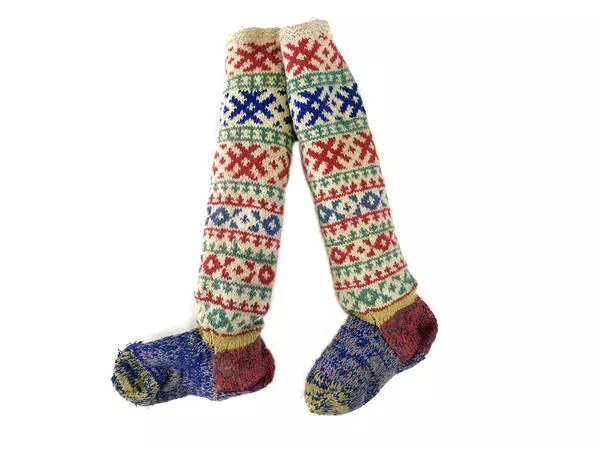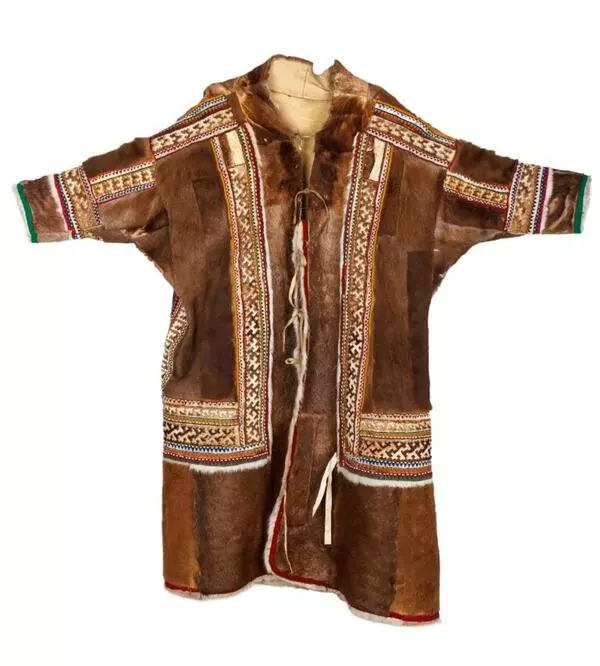In the culture of the northern peoples, the status of a person is determined by different items. Thus, the Khanty consider the hunting belt to be a symbol of a man’s dignity. And the status of a woman can be defined by a “tutchan” bag for sewing accessories.
This small oval bag is sewn of deer fur. It consists of two parts, between which a fur strip is inserted to create volume. The neck is additionally elongated with suede tanned deer skin, which is called “rovduga”. This bag element is sometimes painted in a reddish color, and in rare cases it is decorated with an ornament. To one side a diamond-shaped needle holder is sewn, in the lower part of which is a place for a thimble.
Tutchan is decorated in a traditional technique called “fur mosaic”. Craftswomen make various patterns from pieces of fur. This work takes as much time as the process of manufacturing the bag. The Northern peoples believe that the product can be used only when its ornament is completed.
The central part of the bag is most often decorated with a rosette in a form of a stylized image of an animal or some household item. Sometimes craftswomen use a linear-geometric pattern as a decoration.
A pattern is made of large pieces of dark and light fur with short hair. Most often, artisans use forehead deerskins and calfskins. The central part of the bag is framed with strips of black (less often brown) leather; the seams are made with colored cloth. The contrast of the dark-white fur ornament with the bright color of the cloth and the smooth texture of the leather makes the bag look elegant. Strips of leather decorate the side connecting strips of the bag, alternating them with white fur or ornamental ribbons. Tutchan is also richly decorated with pendants made of rings, chains, coins, and beads.
The museum houses a patterned fur bag, which was created in 1995 by the People’s Master of Russia Nina Kaksina in the village of Kazym in the Beloyarsky district. The bag is made of deer and squirrel fur and leather and is decorated with an ornament of fur mosaic of different shades.
This small oval bag is sewn of deer fur. It consists of two parts, between which a fur strip is inserted to create volume. The neck is additionally elongated with suede tanned deer skin, which is called “rovduga”. This bag element is sometimes painted in a reddish color, and in rare cases it is decorated with an ornament. To one side a diamond-shaped needle holder is sewn, in the lower part of which is a place for a thimble.
Tutchan is decorated in a traditional technique called “fur mosaic”. Craftswomen make various patterns from pieces of fur. This work takes as much time as the process of manufacturing the bag. The Northern peoples believe that the product can be used only when its ornament is completed.
The central part of the bag is most often decorated with a rosette in a form of a stylized image of an animal or some household item. Sometimes craftswomen use a linear-geometric pattern as a decoration.
A pattern is made of large pieces of dark and light fur with short hair. Most often, artisans use forehead deerskins and calfskins. The central part of the bag is framed with strips of black (less often brown) leather; the seams are made with colored cloth. The contrast of the dark-white fur ornament with the bright color of the cloth and the smooth texture of the leather makes the bag look elegant. Strips of leather decorate the side connecting strips of the bag, alternating them with white fur or ornamental ribbons. Tutchan is also richly decorated with pendants made of rings, chains, coins, and beads.
The museum houses a patterned fur bag, which was created in 1995 by the People’s Master of Russia Nina Kaksina in the village of Kazym in the Beloyarsky district. The bag is made of deer and squirrel fur and leather and is decorated with an ornament of fur mosaic of different shades.






